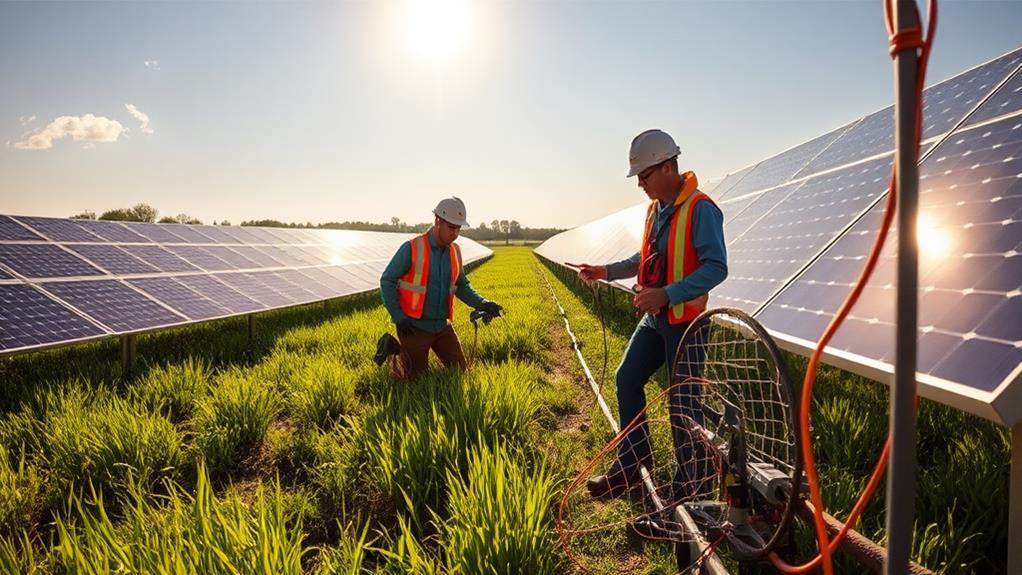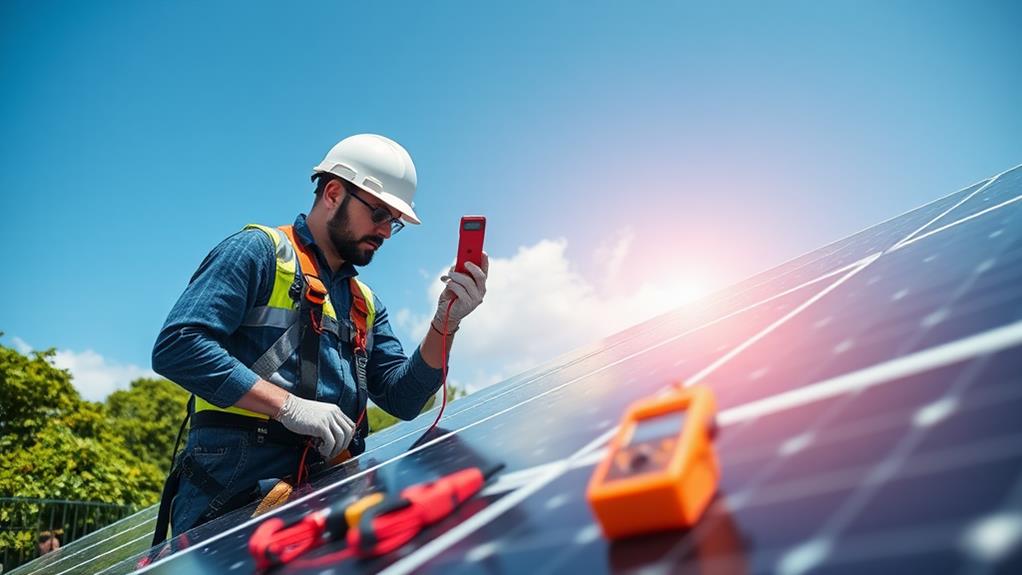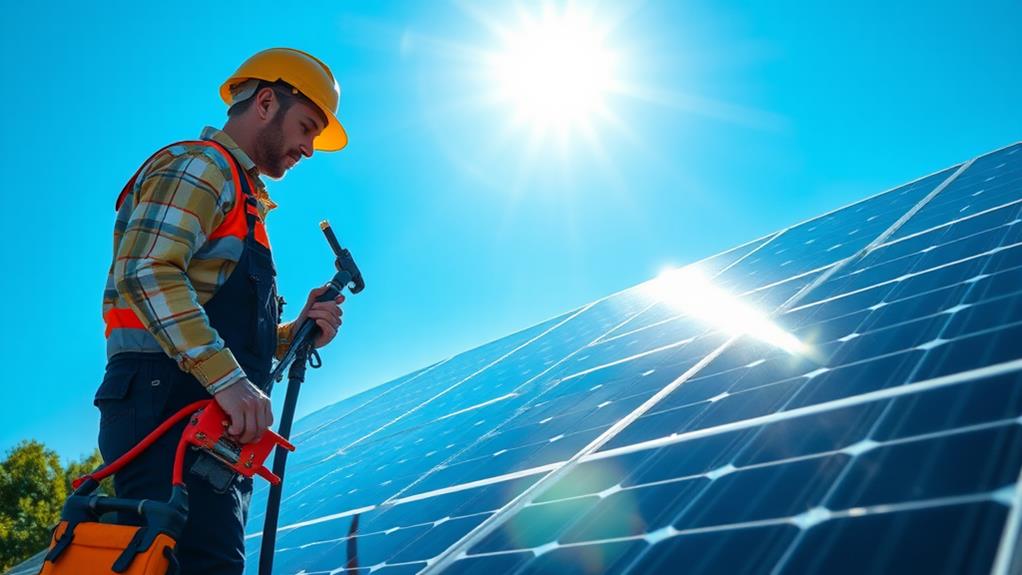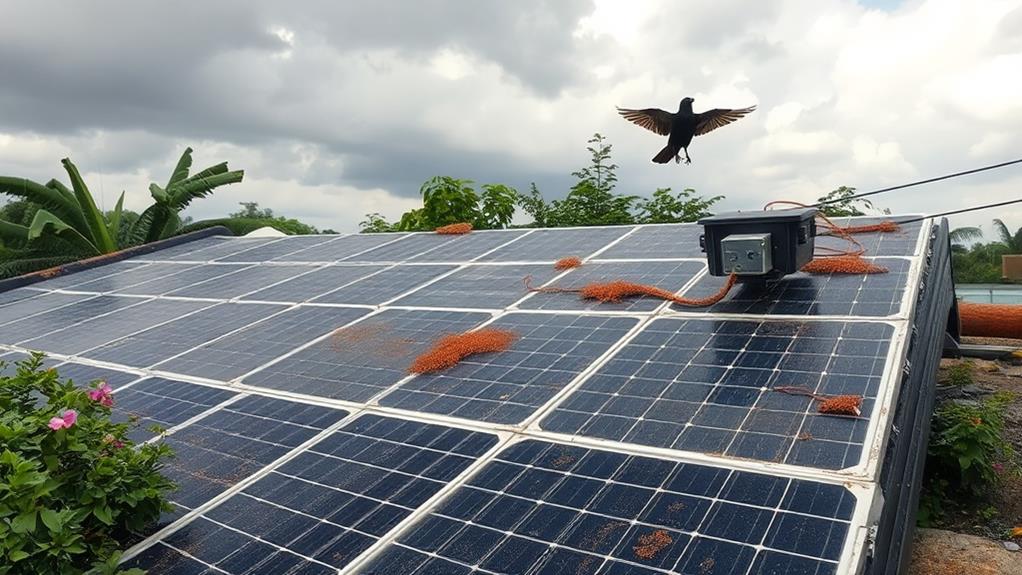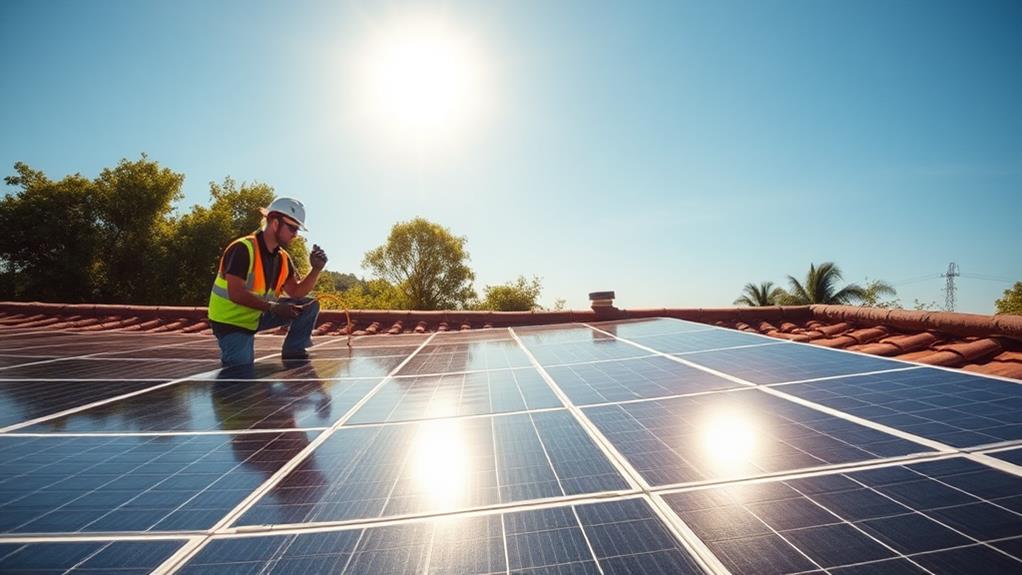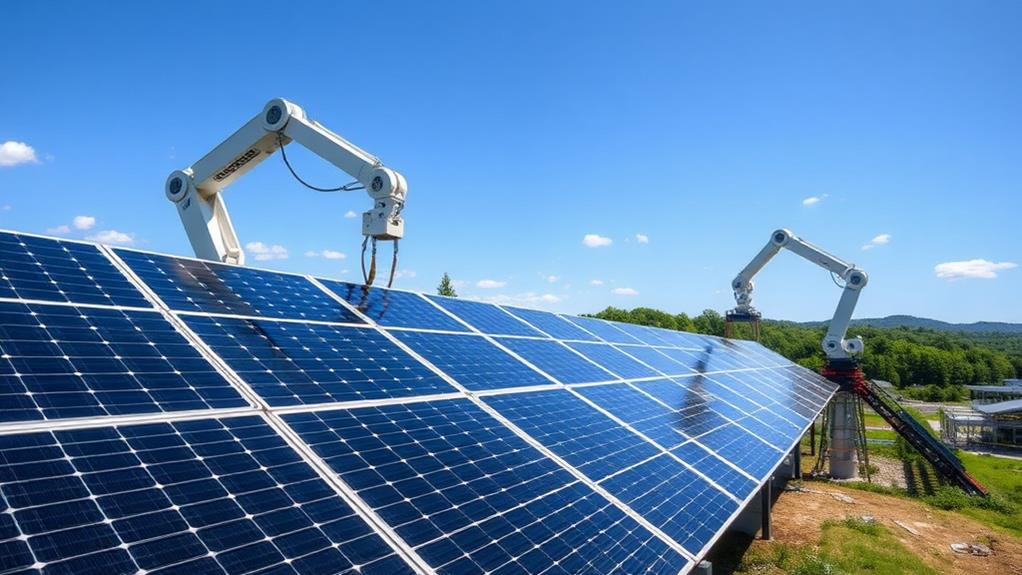We guarantee safety and efficiency in solar systems by regularly monitoring and testing solar grounding systems. Proper grounding provides a low-resistance path for fault currents, uncovering electrical potential issues and decreasing fire hazards. We utilize tools such as earth resistance meters and ground fault detectors for precision. Following regulatory compliance keeps our systems safe and investments protected. Common challenges like soil resistivity necessitate specialized equipment and expertise for accurate evaluation. Regular testing safeguards solar installations from damage and prolongs their lifespan. We'll investigate these techniques and best practices to uphold peak performance and safety for your solar installations.
Key Takeaways
- Soil resistivity testing evaluates ground conditions to ensure effective solar earthing system performance.
- Continuity testing verifies connection integrity to prevent solar power system compromise.
- Regular visual inspections help identify damage, corrosion, or loose connections in the earthing system.
- Ground fault detection devices and data logging systems maintain continuous monitoring for faults.
- Earth resistance meters measure grounding system resistance, ensuring safety and preventing electrical hazards.
Importance of Solar Earthing
Ensuring the safety and efficiency of solar power systems, solar earthing holds immense significance. As a community focused on sustainable energy, we understand the critical role of grounding in solar installations. Proper earthing stabilises electrical potentials, enhancing both safety and reliability, while reducing electrical risks that could jeopardise our investment in clean energy.
It provides a low-resistance path for fault currents, essential for preventing faults. This proactive measure safeguards solar equipment from potential damage caused by faults and lightning strikes, ensuring our systems remain operational and efficient.
Solar earthing is also crucial for protecting rooftop solar panels during lightning events. Effective earthing prevents high voltage damage, maintaining the integrity of solar systems. This is vital for feeling secure and confident in our investment.
Regular testing and maintenance of earthing systems ensure continued effectiveness, adhering to industry standards for safety and performance. Prioritising these practices means we aren't only protecting our solar assets but also fostering a sense of belonging within a community that values reliability and sustainability in renewable energy solutions.
For instance, the Schneider Electric Easy9 range offers reliable earthing solutions. Investing in such reputable products ensures long-term protection and peace of mind. Regular checks and adherence to safety standards should be a priority for anyone serious about their renewable energy systems.
Ensuring Regulatory Compliance
When maintaining the integrity of our solar earthing systems, regulatory compliance is essential. We all wish to be part of a community that prioritises safety and reliability, and adhering to regulatory requirements is central to achieving that goal. Compliance verification isn't merely about ticking boxes; it's about safeguarding our investments and ensuring peace of mind.
Following local regulations confirms that our earthing systems are installed and maintained correctly, helping us avoid costly penalties and potential system shutdowns.
Industry standards exist to prevent risks and enhance the reliability of our systems. Regular monitoring and testing of solar earthing setups are crucial. This action not only verifies compliance with relevant guidelines but also strengthens the trust in our shared energy solutions. Non-compliance affects everyone, leading to safety hazards that could have been prevented.
Commitment to regulatory adherence reinforces our collective responsibility and demonstrates our dedication to a sustainable, secure energy future.
For those seeking specific solutions, the DEHN earthing system offers reliable components that meet stringent safety standards. Consider integrating these into your installations to ensure optimal performance and safety.
Safety and Risk Management
As we focus on safety and risk management in solar earthing systems, it's important we guarantee system safety to protect both people and property. By mitigating electrical risks like shocks and fire hazards, we improve the overall protection of our solar equipment.
Let's prioritize effective grounding to shield our installations from overvoltages and surges, guaranteeing long-term efficiency and safety.
Ensuring System Safety
Safety is paramount in solar grounding systems as they protect individuals and equipment. Ensuring solar systems are efficient and secure is essential. Fault detection is crucial, helping identify potential issues before they escalate into serious problems. Regular monitoring and testing ensure any anomalies are promptly addressed, keeping systems secure and reliable.
Ground resistance is a key factor in system safety. Lower resistance allows the system to divert harmful electrical currents away from valuable equipment and into the ground, reducing the risk of electrical shocks or fire hazards. This contributes to a safer environment for everyone involved.
Adhering to safety standards and compliance regulations isn't just about avoiding penalties; it reflects a commitment to safety and excellence.
A well-designed grounding system improves system longevity and performance, ensuring solar investments provide clean and secure energy for years. Reputable products, such as the Schneider Electric Conext SW Inverter, offer reliable performance and adhere to safety standards.
Mitigating Electrical Risks
To effectively address electrical risks in solar installations, proper grounding must be prioritised as a key component of safety and risk management. Conducting thorough risk assessments identifies potential hazards, allowing for the implementation of solutions that safeguard both the system and its users. Proper grounding provides a low-resistance path for fault currents, essential in preventing electrical faults and enhancing overall safety.
Fault detection is crucial for maintaining safe and efficient solar installations. Integrating robust fault detection systems offers a proactive approach to identifying issues before they escalate into significant problems. This approach protects equipment from damage due to electrical faults and lightning strikes while extending the lifespan of the solar system. Products like the SMA Sunny Boy Inverter, priced from 10,000 ZAR, are recommended for their reliable fault detection capabilities.
Proper grounding stabilises electrical potentials, enhancing system reliability, efficiency, and stability. It reduces electromagnetic interference, ensuring optimal performance of solar installations. Preventing transient overvoltages minimises safety hazards and avoids potential performance degradation.
The Victron Energy Blue Power Charger, available for approximately 2,500 ZAR, is a recommended product to maintain stability and performance.
Our community's commitment to solar energy acknowledges that mandatory grounding isn't just a technical requirement—it's a shared commitment to a safer, more reliable energy future.
Enhancing Equipment Protection
Enhancing equipment protection is vital for solar installations to mitigate electrical risks. Proper solar earthing acts as a safeguard against electrical faults and lightning strikes, which could otherwise jeopardise our systems. Ensuring a robust earthing setup not only protects equipment from overvoltages and electrical surges but also maintains the integrity of our investment in renewable energy.
Our community values the reliability of equipment maintenance and system performance, both anchored in effective earthing. A low-resistance path for fault currents is essential. It significantly reduces the risk of fire hazards, providing peace of mind to everyone prioritising safety and efficiency. Reliable earthing systems stabilise electrical potentials, enhancing the longevity of solar installations, ensuring they serve us effectively for many years.
For optimal performance, consider using products like the DEHNguard surge protection device, which is specifically designed to shield solar systems from surges and lightning strikes. This device is a wise investment, costing around 1,500 ZAR, and adds an extra layer of protection to your solar setup.
Additionally, the Schneider Electric Easy9 RCCB is a recommended choice for ensuring a low-resistance path for fault currents, available at approximately 1,200 ZAR.
These recommendations ensure that solar installations not only meet safety standards but also operate efficiently, safeguarding our commitment to renewable energy.
Testing Procedures Overview
In testing procedures for solar earthing systems, resistance tests, continuity checks, and soil resistivity measurements are performed to ensure optimal functionality. Tools like insulation resistance meters and multimeters assess whether the earthing system meets standards. Resistance testing identifies potential issues that may compromise the safety and efficiency of the solar setup.
Soil resistivity measurement determines how well the earth conducts electricity, crucial for grounding effectiveness.
The shared goal is ensuring the safety and reliability of solar systems, with regular testing being a proactive step in this direction. It resembles a community effort to prevent electrical hazards affecting not just systems, but also the broader environment.
Conducting live-dead-live testing confirms circuit de-energisation, ensuring maintenance or repairs are performed safely.
Proper documentation of testing results is more than a regulatory requirement; it's a declaration of commitment to maintaining strong system performance. Keeping detailed records contributes to a collective knowledge base benefiting everyone in the solar community.
For example, the Fluke 1587 FC Insulation Multimeter is recommended for combining insulation testing with a full-featured, true-RMS digital multimeter in a single, compact device.
Monitoring Techniques Explained
In monitoring solar earthing systems, we employ various techniques that ensure safety and efficiency. As a community dedicated to excellence, understanding our earthing systems is essential. Soil resistivity testing is a fundamental technique used to evaluate ground conditions and the effectiveness of earthing systems. Measuring the soil's electrical conductivity ensures proper grounding, providing safety and optimal performance.
Continuity testing is another crucial method. This checks the integrity of the connections between solar components and the earthing system. Ensuring these connections are robust prevents issues like loose fittings or corrosion, which could compromise the entire system.
A recommended product for this purpose is the Fluke 1664 FC Multifunction Installation Tester, which is known for its reliability and precision.
Regular inspections and visual checks are routine practices. They help quickly identify damage, corrosion, or loose connections that could threaten safety and efficiency. Ground fault detection devices, such as the Schneider Electric Vigi C60, are integrated alongside data logging systems to maintain continuous vigilance. These devices alert to any faults, enabling proactive maintenance and effective troubleshooting. Together, these methods form the backbone of our monitoring strategy.
Tools for Effective Testing
Equipped with specialised tools such as earth resistance meters and ground fault detectors, we ensure our solar earthing systems are both safe and efficient. These devices underpin our testing precision, ensuring every measurement meets the highest safety standards. Our earth resistance meters measure the grounding system's resistance, which is crucial for preventing electrical hazards. Utilising these tools, we confidently affirm that our systems are reliable and comply with necessary safety regulations.
Ground fault detectors are indispensable for pinpointing issues within the earthing system. They assist in identifying problems promptly, allowing us to conduct timely repairs and maintain the system's integrity. We understand the importance of being part of a community that prioritises safety and efficiency, and our dedication to using these tools reflects that.
Some advanced equipment we use includes features like data recording and wireless connectivity. These enhance our equipment's reliability and testing efficiency, enabling real-time monitoring of systems. Consistently using these tools, we guarantee our solar earthing systems remain robust and protected, providing peace of mind to our community.
Common Testing Challenges
Testing solar earthing systems presents several challenges that demand our immediate focus. A significant issue is the variation in soil resistivity, which can severely affect the efficiency of grounding efforts. This variability complicates achieving consistent and precise results, as soil resistance can fluctuate with changes in moisture levels, temperature, and composition. As a community committed to safe solar installations, addressing these fluctuations is paramount.
Access to buried electrodes or grounding components can also be problematic. These elements are sometimes located in difficult-to-reach areas, complicating testing efforts further. Additionally, equipment corrosion can lead to unreliable results. Corroded connections may introduce inconsistencies, making it difficult to accurately assess the condition of the earthing system. Accurate testing is crucial for ensuring the safety and reliability of our systems.
Overcoming these challenges requires specialised equipment and expertise. Comprehensive assessments need tools and knowledge that can adapt to the unique conditions of each site. For instance, using a Megger Earth Tester can provide precise measurements in varying soil conditions. Sharing insights and experiences within the community helps maintain the integrity of our solar earthing systems.
Best Practices for Maintenance
Regular maintenance of solar earthing systems ensures their long-term effectiveness and safety. As a community dedicated to sustainable energy, adopting best practices keeps our systems efficient and reliable. Conducting periodic resistance testing is essential. This confirms that earthing systems function properly, allowing for the timely addressing of deficiencies before they escalate into significant problems.
Implementing thorough inspection protocols is equally important. Inspections should check for corrosion, damage, and loose connections, all of which can compromise system performance. Early identification of these issues enables proactive maintenance, ensuring the systems continue to serve our community safely.
Using specialist equipment that meets industry standards is vital. Accurate testing requires appropriate tools. For instance, the Megger DET3TC Earth Tester is a recommended device that aligns with best practices, maintaining the integrity of solar earthing systems.
Commitment to a structured maintenance schedule prevents problems from arising, promoting a sense of security and unity as we move towards a sustainable energy future.
Conclusion
We've looked into the importance of keeping an eye on and testing solar earthing systems. By ensuring we follow regulations and manage safety risks, we protect our investments and ourselves. We've explored testing methods, monitoring techniques, and necessary tools to keep the system working efficiently. While there might be challenges, sticking to best practices ensures our solar systems stay reliable.
If you have any questions about our products or services, please get in touch with Deo Solar. We offer a range of products including Rail-Less Solar Brackets, End Spacers, Structural Brackets, Ground Mounted Solar Systems, Corrugated Brackets, and Earthing Plates. Our services include the DeoSizer Tool, Evaluation and Design, Maintenance and Support, and Solar Installations. We invite you to reach out to us to learn more.

